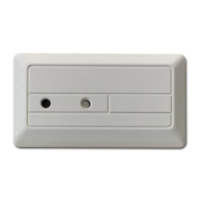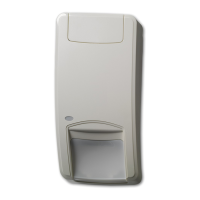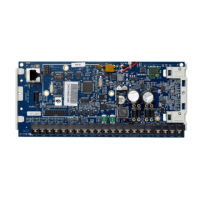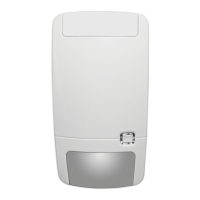P/N 422-6367-ML • REV E • ISS 03DEC18 3 / 14
• Clear “line-of-sight” between the “microphone” of the
detector and the glass is required.
• Detector location for wall or ceiling mount is shown in
Figure 10.
- Distance between the glass and the detector should be 1
to 9 m.
- Detector should be installed min. 50 cm from a corner.
- Detector should be installed min. 1 m over the floor.
- Detector should be installed min. 30 cm from the ceiling
(at wall mounting).
• Detector should be installed on a flat surface, which is free
from objects in a radius of 50 cm from the detector.
• Detector should not be installed close to air vents or big
sound reflecting obstacles.
• Never mount the detector in the corners.
Installation
1. Choose the best mounting position on the wall or ceiling.
2. Loosen the cover screw and remove the upper part
3. Use the bottom part as a template and mark the place of
the holes of with a pen
4. Use a 2.5 mm drill for the self-tapping screws provided. If
necessary, use wall anchors
5. If necessary, cut out the marked “knockout hole” on the
back of the base with a pair of tongs
6. Pull the wiring cable through the “knockout hole” in the
bottom plate
7. Connect the wires to the screw terminals. See Table 1
below for information.
8. Use the cable strap provided to fix the wiring cable to the
detector.
9. Fix the detector firmly to the base with the enclosed
screws.
10. Set the desired range, i.e. the detector sensitivity setting
by using the DIP switch no 2 and 3. See “DIP switch”
below for details.
11. Check the window constructions and note what kind of
glass is used and especially in the pane closest to the
room.
Table 1: Terminal pins
Day and Night control of LED
INTRUSION relay output NC
Spare contact (unconnected)
Spare contact (unconnected)
Spare contact (unconnected)
Spare contact (unconnected)
Spare contact (unconnected)
Note: You can use the additional accessory GS960-RB plug-in
EOL resistor board, which allows you to easily integrate GS960
into an existing Advisor Advanced system without the hassle of
adding EOL resistors.
DIP switch
DIP switch functions are described in Table 2 below.
Table 2: DIP switch functions
INTRUSION relay mode
• DIP 1 ON: INTRUSION relay mode ON means the
INTRUSION relay will Latch and be open in alarm.
• DIP 1 OFF: INTRUSION relay mode OFF means the
INTRUSION relay will be auto reset after 2 seconds in
alarm.
Range
DIP switch range settings are shown in Figure 6.
Figure 6: DIP switch range settings
(1) 4 to 9 m, Zone 1: OFF, OFF
(2) 2 to 4 m, Zone 2: OFF, ON, or ON, OFF
(3) 1 to 2 m, Zone 3: ON, ON
Suggested settings of the detector
depending on window design and type of
glass
Check the window constructions and note what kind of glass is
used and especially in the pane closest to the room.
• Single glazed (float & tempered) – Set the detector at the
measured distance from the glass to the detector.
• Double glazed (float & tempered). If there are high
disturbances in the surroundings – set the detector at the
measured distance from the glass to the detector. At
normal or low disturbances – the detector shall be set at
Zone 1.
• Double glazed where the inner pane is covered with
security film – Set the detector at Zone 1 apart from the
measured distance.
• Triple glazed (float & tempered) – Set the detector at
Zone 1 apart from measured distance.
• Laminated glass – Set the detector at Zone 1 apart from
the measured distance.

